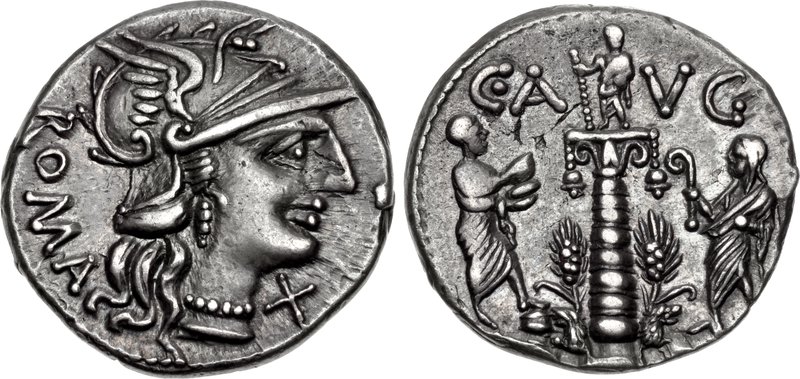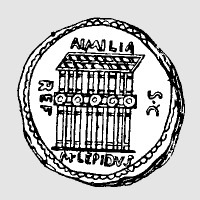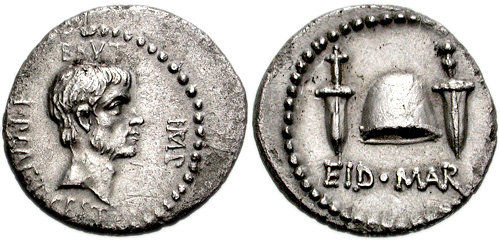|
Battle Of Philippi
The Battle of Philippi was the final battle in the Wars of the Second Triumvirate between the forces of Mark Antony and Octavian (of the Second Triumvirate) and the leaders of Julius Caesar's assassination, Brutus and Cassius in 42 BC, at Philippi in Macedonia. The Second Triumvirate declared the civil war ostensibly to avenge Julius Caesar's assassination in 44 BC, but the underlying cause was a long-brewing conflict between the so-called Optimates and the so-called Populares. The battle, involving up to 200,000 men in one of the largest of the Roman civil wars, consisted of two engagements in the plain west of the ancient city of Philippi. The first occurred in the first week of October; Brutus faced Octavian, and Antony's forces fought those of Cassius. The Roman armies fought poorly, with low discipline, nonexistent tactical coordination and amateurish lack of command experience evident in abundance with neither side able to exploit opportunities as they developed. At ... [...More Info...] [...Related Items...] OR: [Wikipedia] [Google] [Baidu] |
Liberators' Civil War
The Liberators' civil war (43–42 BC) was started by the Second Triumvirate to avenge Julius Caesar's assassination. The war was fought by the forces of Mark Antony and Octavian (the Second Triumvirate members) against the forces of Caesar's assassins, led by Marcus Junius Brutus and Gaius Cassius Longinus, also called the ''Liberatores''. The latter were defeated by the Triumvirs at the Battle of Philippi in October 42 BC, and committed suicide. Brutus would also commit suicide after the second part of the battle. Prelude After the murder of Caesar, Brutus and Cassius (the two main conspirators, also known as the Liberatores) had left Italy and taken control of all Eastern provinces (from Greece and Macedonia to Syria) and of the allied Eastern kingdoms. In Rome the three main Caesarian leaders (Antony, Octavian and Marcus Aemilius Lepidus), who controlled almost all the Roman army in the west, had crushed the opposition of the senate and established the second triumvirate ... [...More Info...] [...Related Items...] OR: [Wikipedia] [Google] [Baidu] |
Optimates
Optimates (; Latin for "best ones", ) and populares (; Latin for "supporters of the people", ) are labels applied to politicians, political groups, traditions, strategies, or ideologies in the late Roman Republic. There is "heated academic discussion" as to whether Romans would have recognised an ideological content or political split in the label. Among other things, ''optimates'' have been seen as supporters of the continued authority of the Roman senate, senate, politicians who operated mostly in the senate, or opponents of the ''populares''. The ''populares'' have also been seen as focusing on operating before the Constitution of the Roman Republic#Assemblies, popular assemblies, generally in opposition to the Roman senate, senate, using "the populace, rather than the senate, as a means [for advantage]". References to optimates (also called ''boni'', "good men") and ''populares'' are found among the writings of Roman authors of the 1st century BC. The distinction bet ... [...More Info...] [...Related Items...] OR: [Wikipedia] [Google] [Baidu] |
Adriatic Sea
The Adriatic Sea () is a body of water separating the Italian Peninsula from the Balkan Peninsula. The Adriatic is the northernmost arm of the Mediterranean Sea, extending from the Strait of Otranto (where it connects to the Ionian Sea) to the northwest and the Po Valley. The countries with coasts on the Adriatic are Albania, Bosnia and Herzegovina, Croatia, Italy, Montenegro, and Slovenia. The Adriatic contains more than 1,300 islands, mostly located along the Croatian part of its eastern coast. It is divided into three basins, the northern being the shallowest and the southern being the deepest, with a maximum depth of . The Otranto Sill, an underwater ridge, is located at the border between the Adriatic and Ionian Seas. The prevailing currents flow counterclockwise from the Strait of Otranto, along the eastern coast and back to the strait along the western (Italian) coast. Tidal movements in the Adriatic are slight, although larger amplitudes are known to occur occasi ... [...More Info...] [...Related Items...] OR: [Wikipedia] [Google] [Baidu] |
Roman Army
The Roman army (Latin: ) was the armed forces deployed by the Romans throughout the duration of Ancient Rome, from the Roman Kingdom (c. 500 BC) to the Roman Republic (500–31 BC) and the Roman Empire (31 BC–395 AD), and its medieval continuation, the Eastern Roman Empire. It is thus a term that may span approximately 2,205 years (753 BC–1453 AD), during which the Roman armed forces underwent numerous permutations in size, composition, organisation, equipment and tactics, while conserving a core of lasting traditions. Historical overview Early Roman army (c. 500 BC to c. 300 BC) The early Roman army was the armed forces of the Roman Kingdom and of the early Roman Republic. During this period, when warfare chiefly consisted of small-scale plundering raids, it has been suggested that the army followed Etruscan or Greek models of organisation and equipment. The early Roman army was based on an annual levy. The army consisted of 3,000 infantrymen and 300 cavalrymen, all of ... [...More Info...] [...Related Items...] OR: [Wikipedia] [Google] [Baidu] |
Marcus Aemilius Lepidus (triumvir)
Marcus Aemilius Lepidus (; c. 89 BC – late 13 or early 12 BC) was a Roman general and statesman who formed the Second Triumvirate alongside Octavian and Mark Antony during the final years of the Roman Republic. Lepidus had previously been a close ally of Julius Caesar. He was also the last '' pontifex maximus'' before the Roman Empire, and (presumably) the last ''interrex'' and ''magister equitum'' to hold military command. Though he was an able military commander and proved a useful partisan of Caesar, Lepidus has always been portrayed as the least influential member of the Triumvirate. He typically appears as a marginalised figure in depictions of the events of the era, most notably in Shakespeare's plays. While some scholars have endorsed this view, others argue that the evidence is insufficient to discount the distorting effects of propaganda by his opponents, principally Cicero and, later, Augustus. Family Lepidus was the son of Marcus Aemilius Lepidus (consul in 78 ... [...More Info...] [...Related Items...] OR: [Wikipedia] [Google] [Baidu] |
Syria (Roman Province)
Roman Syria was an early Roman province annexed to the Roman Republic in 64 BC by Pompey in the Third Mithridatic War following the defeat of King of Armenia Tigranes the Great. Following the partition of the Herodian Kingdom of Judea into tetrarchies in 6 AD, it was gradually absorbed into Roman provinces, with Roman Syria annexing Iturea and Trachonitis. Provincia Syria Syria was annexed to the Roman Republic in 64 BC, when Pompey the Great had the Seleucid king Antiochus XIII Asiaticus executed and deposed his successor Philip II Philoromaeus. Pompey appointed Marcus Aemilius Scaurus to the post of Proconsul of Syria. Following the fall of the Roman Republic and its transformation into the Roman Empire, Syria became a Roman imperial province, governed by a Legate. During the early empire, the Roman army in Syria accounted for three legions with auxiliaries who defended the border with Parthia. In 6 AD Emperor Augustus deposed the ethnarch Herod Archelaus and united J ... [...More Info...] [...Related Items...] OR: [Wikipedia] [Google] [Baidu] |
Greece In The Roman Era
Greece in the Roman era describes the Roman conquest of Greece, as well as the period of Greek history when Greece was dominated first by the Roman Republic and then by the Roman Empire. The Roman era of Greek history began with the Corinthian defeat in the Battle of Corinth in 146 BC. However, before the Achaean War, the Roman Republic had been steadily gaining control of mainland Greece by defeating the Kingdom of Macedon in a series of conflicts known as the Macedonian Wars. The Fourth Macedonian War ended at the Battle of Pydna in 148 BC with the defeat of the Macedonian royal pretender Andriscus. The definitive Roman occupation of the Greek world was established after the Battle of Actium (31 BC), in which Augustus defeated Cleopatra VII, the Greek Ptolemaic queen of Egypt, and the Roman general Mark Antony, and afterwards conquered Alexandria (30 BC), the last great city of Hellenistic Egypt. The Roman era of Greek history continued with Emperor Constantine the Great's ... [...More Info...] [...Related Items...] OR: [Wikipedia] [Google] [Baidu] |
Italy
Italy ( it, Italia ), officially the Italian Republic, ) or the Republic of Italy, is a country in Southern Europe. It is located in the middle of the Mediterranean Sea, and its territory largely coincides with the homonymous geographical region. Italy is also considered part of Western Europe, and shares land borders with France, Switzerland, Austria, Slovenia and the enclaved microstates of Vatican City and San Marino. It has a territorial exclave in Switzerland, Campione. Italy covers an area of , with a population of over 60 million. It is the third-most populous member state of the European Union, the sixth-most populous country in Europe, and the tenth-largest country in the continent by land area. Italy's capital and largest city is Rome. Italy was the native place of many civilizations such as the Italic peoples and the Etruscans, while due to its central geographic location in Southern Europe and the Mediterranean, the country has also historically been home ... [...More Info...] [...Related Items...] OR: [Wikipedia] [Google] [Baidu] |
Liberatores
Julius Caesar, the Roman dictator, was assassinated by a group of senators on the Ides of March (15 March) of 44 BC during a meeting of the Senate at the Curia of Pompey of the Theatre of Pompey in Rome where the senators stabbed Caesar 23 times. They claimed to be acting over fears that Caesar's unprecedented concentration of power during his dictatorship was undermining the Roman Republic. At least 60 senators were party to the conspiracy, led by Marcus Junius Brutus and Gaius Cassius Longinus. Despite the death of Caesar, the conspirators were unable to restore the institutions of the Republic. The ramifications of the assassination led to the Liberators' civil war and ultimately to the Principate period of the Roman Empire. Causes Caesar had served the Republic for eight years in the Gallic Wars, fully conquering the region of Gaul (roughly equivalent to modern-day France). After the Roman Senate demanded Caesar to disband his army and return home as a civilian, he ref ... [...More Info...] [...Related Items...] OR: [Wikipedia] [Google] [Baidu] |
Roman Republic
The Roman Republic ( la, Res publica Romana ) was a form of government of Rome and the era of the classical Roman civilization when it was run through public representation of the Roman people. Beginning with the overthrow of the Roman Kingdom (traditionally dated to 509 BC) and ending in 27 BC with the establishment of the Roman Empire, Rome's control rapidly expanded during this period—from the city's immediate surroundings to hegemony over the entire Mediterranean world. Roman society under the Republic was primarily a cultural mix of Latin and Etruscan societies, as well as of Sabine, Oscan, and Greek cultural elements, which is especially visible in the Roman Pantheon. Its political organization developed, at around the same time as direct democracy in Ancient Greece, with collective and annual magistracies, overseen by a senate. The top magistrates were the two consuls, who had an extensive range of executive, legislative, judicial, military, and religious powers ... [...More Info...] [...Related Items...] OR: [Wikipedia] [Google] [Baidu] |
Suicide
Suicide is the act of intentionally causing one's own death. Mental disorders (including depression, bipolar disorder, schizophrenia, personality disorders, anxiety disorders), physical disorders (such as chronic fatigue syndrome), and substance abuse (including alcoholism and the use of and withdrawal from benzodiazepines) are risk factors. Some suicides are impulsive acts due to stress (such as from financial or academic difficulties), relationship problems (such as breakups or divorces), or harassment and bullying. Those who have previously attempted suicide are at a higher risk for future attempts. Effective suicide prevention efforts include limiting access to methods of suicide such as firearms, drugs, and poisons; treating mental disorders and substance abuse; careful media reporting about suicide; and improving economic conditions. Although crisis hotlines are common resources, their effectiveness has not been well studied. The most commonly adopted metho ... [...More Info...] [...Related Items...] OR: [Wikipedia] [Google] [Baidu] |
Roman Legion
The Roman legion ( la, legiō, ) was the largest military unit of the Roman army, composed of 5,200 infantry and 300 equites (cavalry) in the period of the Roman Republic (509 BC–27 BC) and of 5,600 infantry and 200 auxilia in the period of the Roman Empire (27 BC – AD 476). Size The size of a typical legion varied throughout the history of ancient Rome, with complements ranging from 4,200 legionaries and 300 equites (drawn from the wealthier classes – in early Rome all troops provided their own equipment) in the Republican period of Rome (the infantry were split into 10 cohorts each of four maniples of 120 legionaries), to 4,800 legionaries (in 10 cohorts of 6 centuries of 80 legionaries) during Caesar's age, to 5,280 men plus 120 auxiliaries in the Imperial period (split into 10 cohorts, nine of 480 men each, with the first cohort being double-strength at 960 men). It should be noted the above numbers are typical field strengths while "paper strength" was sli ... [...More Info...] [...Related Items...] OR: [Wikipedia] [Google] [Baidu] |







.jpg)